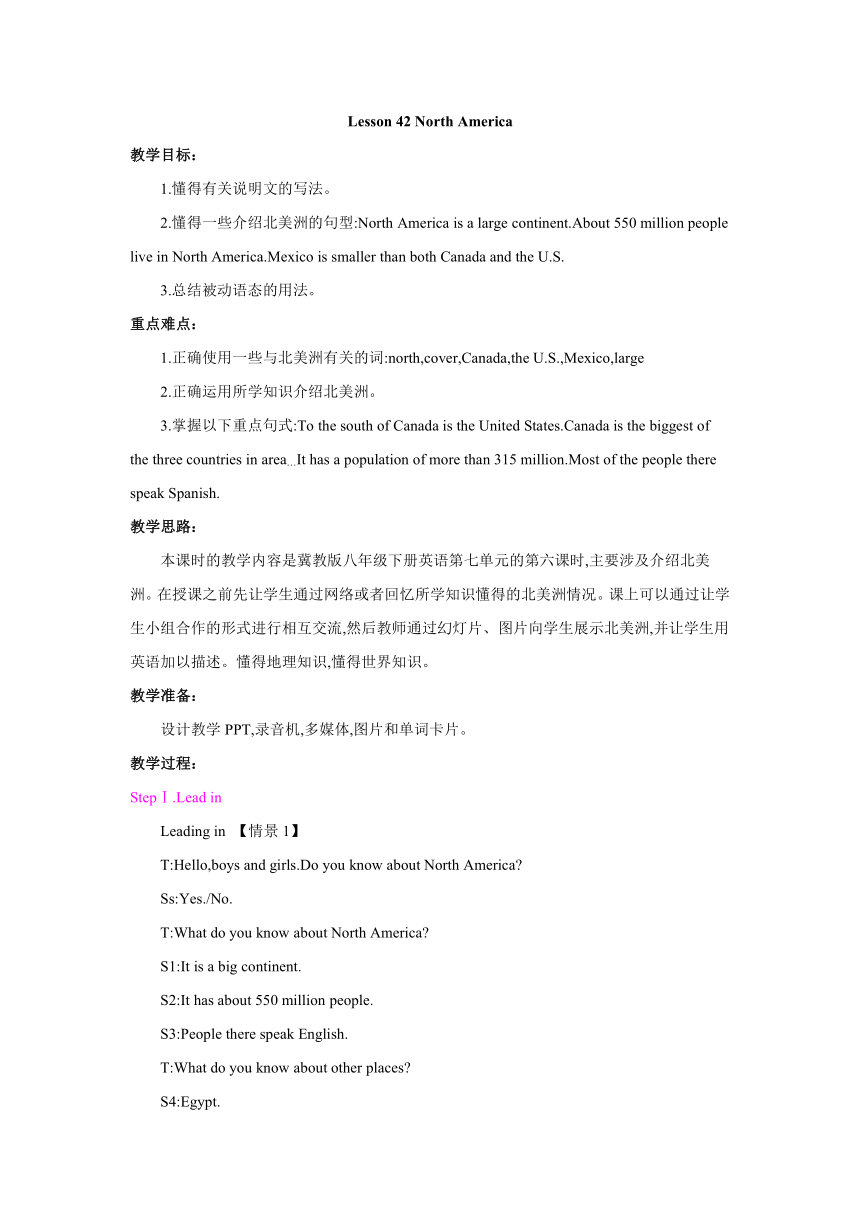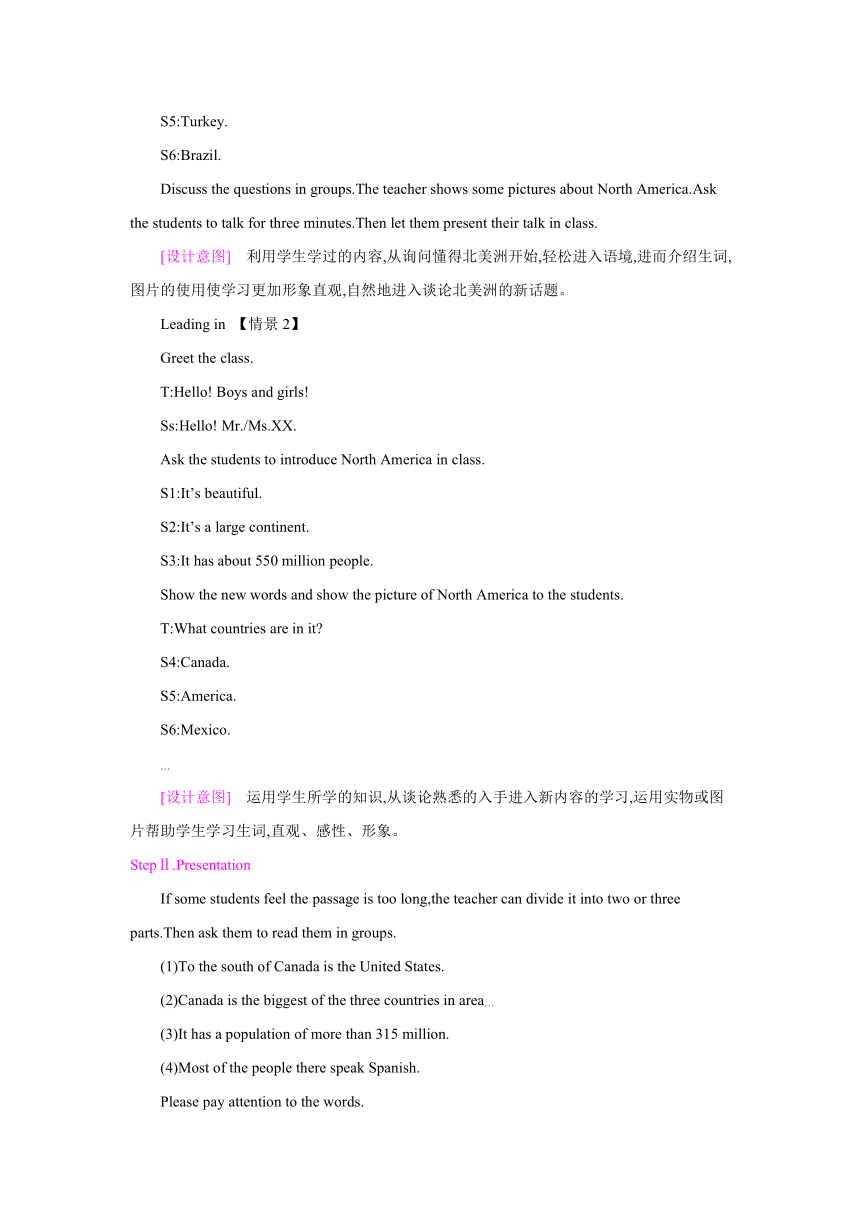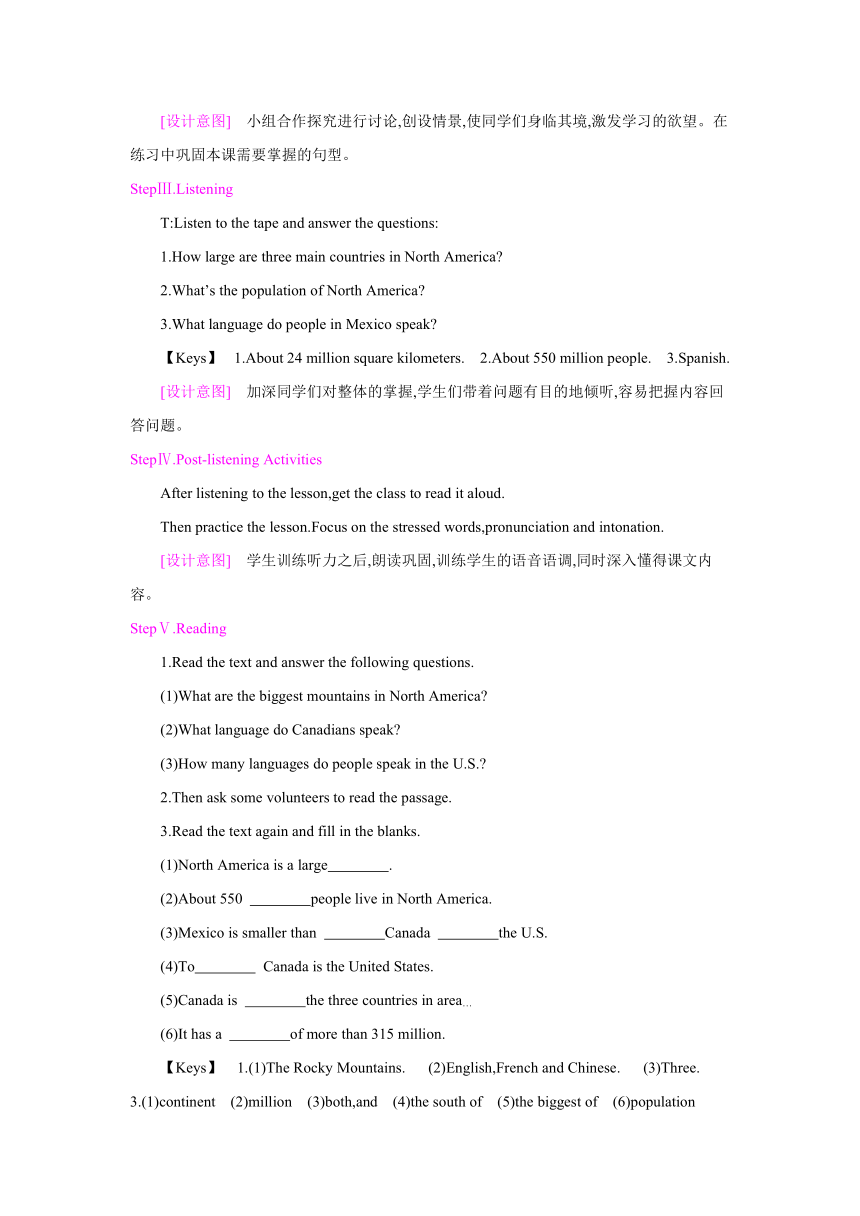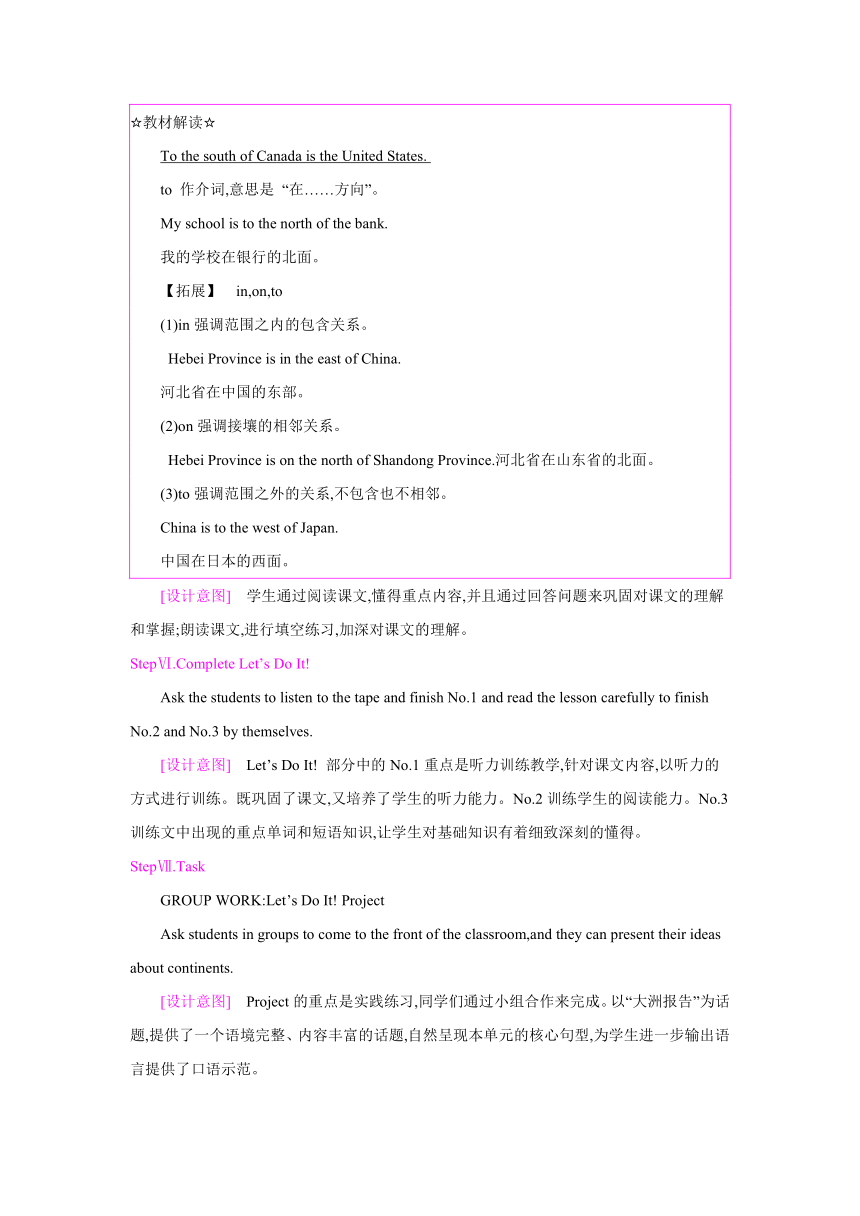Unit 7 Know Our World Lesson 42 North America 教学设计
文档属性
| 名称 | Unit 7 Know Our World Lesson 42 North America 教学设计 |

|
|
| 格式 | zip | ||
| 文件大小 | 29.8KB | ||
| 资源类型 | 教案 | ||
| 版本资源 | 冀教版 | ||
| 科目 | 英语 | ||
| 更新时间 | 2019-06-28 16:57:22 | ||
图片预览




文档简介
Lesson 42 North America
教学目标:
1.懂得有关说明文的写法。
2.懂得一些介绍北美洲的句型:North America is a large continent.About 550 million people live in North America.Mexico is smaller than both Canada and the U.S.
3.总结被动语态的用法。
重点难点:
1.正确使用一些与北美洲有关的词:north,cover,Canada,the U.S.,Mexico,large
2.正确运用所学知识介绍北美洲。
3.掌握以下重点句式:To the south of Canada is the United States.Canada is the biggest of the three countries in area…It has a population of more than 315 million.Most of the people there speak Spanish.
教学思路:
本课时的教学内容是冀教版八年级下册英语第七单元的第六课时,主要涉及介绍北美洲。在授课之前先让学生通过网络或者回忆所学知识懂得的北美洲情况。课上可以通过让学生小组合作的形式进行相互交流,然后教师通过幻灯片、图片向学生展示北美洲,并让学生用英语加以描述。懂得地理知识,懂得世界知识。
教学准备:
设计教学PPT,录音机,多媒体,图片和单词卡片。
教学过程:
StepⅠ.Lead in
Leading in 【情景1】
T:Hello,boys and girls.Do you know about North America?
Ss:Yes./No.
T:What do you know about North America?
S1:It is a big continent.
S2:It has about 550 million people.
S3:People there speak English.
T:What do you know about other places?
S4:Egypt.
S5:Turkey.
S6:Brazil.
Discuss the questions in groups.The teacher shows some pictures about North America.Ask the students to talk for three minutes.Then let them present their talk in class.
[设计意图] 利用学生学过的内容,从询问懂得北美洲开始,轻松进入语境,进而介绍生词,图片的使用使学习更加形象直观,自然地进入谈论北美洲的新话题。
Leading in 【情景2】
Greet the class.
T:Hello! Boys and girls!
Ss:Hello! Mr./Ms.XX.
Ask the students to introduce North America in class.
S1:It’s beautiful.
S2:It’s a large continent.
S3:It has about 550 million people.
Show the new words and show the picture of North America to the students.
T:What countries are in it?
S4:Canada.
S5:America.
S6:Mexico.
…
[设计意图] 运用学生所学的知识,从谈论熟悉的入手进入新内容的学习,运用实物或图片帮助学生学习生词,直观、感性、形象。
StepⅡ.Presentation
If some students feel the passage is too long,the teacher can divide it into two or three parts.Then ask them to read them in groups.
(1)To the south of Canada is the United States.
(2)Canada is the biggest of the three countries in area…
(3)It has a population of more than 315 million.
(4)Most of the people there speak Spanish.
Please pay attention to the words.
[设计意图] 小组合作探究进行讨论,创设情景,使同学们身临其境,激发学习的欲望。在练习中巩固本课需要掌握的句型。
StepⅢ.Listening
T:Listen to the tape and answer the questions:
1.How large are three main countries in North America?
2.What’s the population of North America?
3.What language do people in Mexico speak?
【Keys】 1.About 24 million square kilometers. 2.About 550 million people. 3.Spanish.
[设计意图] 加深同学们对整体的掌握,学生们带着问题有目的地倾听,容易把握内容回答问题。
StepⅣ.Post-listening Activities
After listening to the lesson,get the class to read it aloud.
Then practice the lesson.Focus on the stressed words,pronunciation and intonation.
[设计意图] 学生训练听力之后,朗读巩固,训练学生的语音语调,同时深入懂得课文内容。
StepⅤ.Reading
1.Read the text and answer the following questions.
(1)What are the biggest mountains in North America?
(2)What language do Canadians speak?
(3)How many languages do people speak in the U.S.?
2.Then ask some volunteers to read the passage.
3.Read the text again and fill in the blanks.
(1)North America is a large .?
(2)About 550 people live in North America.?
(3)Mexico is smaller than Canada the U.S.?
(4)To Canada is the United States.?
(5)Canada is the three countries in area…?
(6)It has a of more than 315 million.?
【Keys】 1.(1)The Rocky Mountains. (2)English,French and Chinese. (3)Three. 3.(1)continent (2)million (3)both,and (4)the south of (5)the biggest of (6)population
☆教材解读☆
To the south of Canada is the United States.?
to 作介词,意思是 “在……方向”。
My school is to the north of the bank.
我的学校在银行的北面。
【拓展】 in,on,to
(1)in强调范围之内的包含关系。
Hebei Province is in the east of China.
河北省在中国的东部。
(2)on强调接壤的相邻关系。
Hebei Province is on the north of Shandong Province.河北省在山东省的北面。
(3)to强调范围之外的关系,不包含也不相邻。
China is to the west of Japan.
中国在日本的西面。
[设计意图] 学生通过阅读课文,懂得重点内容,并且通过回答问题来巩固对课文的理解和掌握;朗读课文,进行填空练习,加深对课文的理解。
StepⅥ.Complete Let’s Do It!
Ask the students to listen to the tape and finish No.1 and read the lesson carefully to finish No.2 and No.3 by themselves.
[设计意图] Let’s Do It! 部分中的No.1重点是听力训练教学,针对课文内容,以听力的方式进行训练。既巩固了课文,又培养了学生的听力能力。No.2训练学生的阅读能力。No.3训练文中出现的重点单词和短语知识,让学生对基础知识有着细致深刻的懂得。
StepⅦ.Task
GROUP WORK:Let’s Do It! Project
Ask students in groups to come to the front of the classroom,and they can present their ideas about continents.
[设计意图] Project的重点是实践练习,同学们通过小组合作来完成。以“大洲报告”为话题,提供了一个语境完整、内容丰富的话题,自然呈现本单元的核心句型,为学生进一步输出语言提供了口语示范。
StepⅧ.Exercises
T:Now,look at the sentences with some missing words.Please use proper words to fill them.
1.The new park is about 100 (平方) meters.?
2.My home is (在) the south of the market.?
3.They can speak (西班牙语).?
4.There are seven (大洲) in the world.?
5.Where is (最高的) in the world??
【Keys】 1.square 2.on 3.Spanish 4.continents 5.the highest mountain
[设计意图] 以学评教、强化落实。当堂检测主要是由本节内容组成的形成性评价,利用已知的信息,让学生补充,让他们得到充分的训练。
StepⅨ.Homework
1.Practice the lesson with your group members after class.
2.Copy the new words twice.
[设计意图] 口头练习和单词记忆相结合,复习、归纳,注重语言知识的操练与积累。
Lesson 42 North America
square,north,cover,Canada,the U.S.,Mexico,large
North America is a large continent.
About 550 million people live in North America.
Mexico is smaller than both Canada and the U.S.
To the south of Canada is the United States.
Canada is the biggest of the three countries in area…
It has a population of more than 315 million.
Most of the people there speak Spanish.
教材习题解答
【Lesson 42】
1 1.Mexico. 2.Chinese. 3.The U.S.
2 People there mainly speak Spanish.It’s the third largest country in area in North America.—Mexico
It’s the farthest north in North America.—Canada
Over 2 million people speak Chinese there.It’s the largest country in population in North America.—America
3 square;most common;Spanish;speak;larger;live
【Unit Review】
Building Your Vocabulary
Ⅰ. 1.prepare 2.polite 3.except 4.surface 5.trust 6.tourists 7.kiss
Ⅱ. 1.pronounced 2.increasing 3.translate 4.politely 5.spelt
Grammar in Use
Ⅰ. 1.have been 2.has gone 3.have been 4.has gone 5.has gone;has been
Ⅱ. 1.is spoken 2.not be seen 3.are used 4.will be built 5.be shaken 6.be translated 7.be learnt 8.be treated 9.is said 10.wasn’t invited
Putting It All Together
Ⅰ. 1.China is the biggest country in Asia. 2.More than three billion. 3.Mount Qomolangma.
语法精讲
一、现在完成时
(一)现在完成时的一般用法
1.过去发生的动作已完成,并且对现在造成了影响和后果。
Has she finished her work?
她完成她的工作了吗?
2.过去的动作或状态一直持续到现在,有可能就此停止,也有可能继续下去。
I have not seen him since last January.
我自从去年一月份就没有看见过他。
(二)现在完成时的特殊用法
1.“have/has been in+地点”在某地待了多久。
Linda has been in Shanghai for five years.
琳达住在上海五年了。
2.“have/has been to+地点”表示曾经到过某地。
I have been to Beijing twice.
我去过北京两次。
3.“have/has gone to+地点”表示到某地去了。
Jim has gone to Suzhou.
吉姆去了苏州。
【巧学乐记】
过去发生的动作,对现在的影响和结果,just,already常用着。
过去的动作或状态,一直持续到现在,for,since把时间带。
been to+地名,曾经到过某地行。
gone to+地点,到某地去了已走远。
been in+地方,在某地住了有多久。
二、被动语态
英语中有两种语态:主动语态和被动语态。主动语态表示主语是动作的执行者或发出者,被动语态表示主语是动作的承受者,其动作执行者可以由介词by引出。要想掌握好被动语态就得过四关,哪四关?大家来看一看吧!
(一)被动语态的使用场合
1.不知道或没有必要说明动作的执行者是谁。
The book is written for teachers.
这书是为教师写的。
2.动作的承受者是谈话的中心(这时可带有by引起的短语)。
The shop is run by a young man.
这家商店是由一个年轻人经营的。
3.出于礼貌措辞等方面的考虑不愿说出动作的执行者是谁。
It is generally considered not advisable to smoke here.一般认为在这儿吸烟是不妥当的。
4.被动结构能使句子得到更好的安排。
Liu Dehua appeared on the stage and was warmly applauded by the audience.刘德华出现在台上,观众给予了他热烈的掌声。
【注意】 只有及物动词才有被动语态。不及物动词,如rise,come,go,happen等,没有被动语态。
(二)被动语态的构成形式
被动语态由“助动词be+及物动词的过去分词(即p.p.)”构成。各种时态的被动语态形式见下表:
一般时
进行时
完成时
现在
am/is/are + p.p.
am/is/are being + p.p.
have/has been + p.p.
过去
was/were + p.p.
was/were being + p.p.
had been + p.p.
将来
shall/will be + p.p.
——
——
过去
将来
should/would be+p.p.
——
——
一般将来时的被动结构也可以用am/is/are going to be done表示;过去将来时的被动结构也可以用was/were going to be done表示。
(三)主动语态变为被动语态的步骤
当主动语态变为被动语态时,通常要经过四步:先确定主动句的主语、谓语、宾语,找出其谓语动词;把主动句中谓语动词后面的宾语变为被动句的主语,若宾语是人称代词时,应把宾格变为主格;把主动句中的谓语动词变为“助动词be+及物动词的过去分词”,但时态不能改变;把主动句中谓语动词前面的主语变为被动句中介词by的宾语(没必要说出动作的执行者时可略去“by+宾语”),若主语是人称代词时,应把主格变为宾格。
【拓展】 (1)如果主动句中含有情态动词,变被动语态时要把情态动词放在be之前,即“情态动词+be+p.p.”。
We can finish the work in a month.
→The work can be finished (by us) in a month.
(2)如果主动句中含有动词短语,变被动语态时,不可丢掉短语末尾的介词或副词。
You can look up this word in the dictionary.
→This word can be looked up in the dictionary.
(3)使役动词make,have及感官动词see,hear,watch,feel等后接省略to的不定式作宾语补足语,这样的主动结构在变被动结构时,动词不定式符号to要加上去。
The boss made them work for 16 hours a day.
→They were made to work for 16 hours a day (by the boss).
(4)如果主动句中含有双宾语,变被动语态时,有两种变化:一是将指人的间接宾语变为被动语态的主语时,要将宾格人称代词变为主格人称代词,指物的直接宾语不变;二是将指物的直接宾语变为被动语态的主语,间接宾语不变,但要在其前加介词for或to。
Tom bought me a new book.
→I was bought a new book by Tom./A new book was bought for me by Tom.
(5)如果主动句中含有复合宾语,变被动语态时,常把主动句中的宾语变为被动语态的主语,而把宾语补足语变为主语补足语。
We must keep our classroom clean and tidy.
→Our classroom must be kept clean and tidy.
(四)主动形式表示被动意义的几种情况
1.动词need,want以及短语be (well) worth 等后接动名词时。
The room needs cleaning.这屋子需要打扫。
The piece of music is worth listening to.
这首曲子值得听。
【注意】 动词need,want后接动名词表示被动意义时,若句子的主语为物,后面的动名词相当于动词不定式的被动结构。
2.系动词look,feel,smell,taste,sound,get,turn,become,seem,grow等后接形容词作表语时。
The food looks nice and tastes bad.
这种食物看起来好看,但吃起来糟糕。
3.某些表示主语质地、自身特征的动词,如write,wash,sell,read,drive,cook等与副词well或easily连用时。
The pen writes well.
这支钢笔写起来非常流利。
教学目标:
1.懂得有关说明文的写法。
2.懂得一些介绍北美洲的句型:North America is a large continent.About 550 million people live in North America.Mexico is smaller than both Canada and the U.S.
3.总结被动语态的用法。
重点难点:
1.正确使用一些与北美洲有关的词:north,cover,Canada,the U.S.,Mexico,large
2.正确运用所学知识介绍北美洲。
3.掌握以下重点句式:To the south of Canada is the United States.Canada is the biggest of the three countries in area…It has a population of more than 315 million.Most of the people there speak Spanish.
教学思路:
本课时的教学内容是冀教版八年级下册英语第七单元的第六课时,主要涉及介绍北美洲。在授课之前先让学生通过网络或者回忆所学知识懂得的北美洲情况。课上可以通过让学生小组合作的形式进行相互交流,然后教师通过幻灯片、图片向学生展示北美洲,并让学生用英语加以描述。懂得地理知识,懂得世界知识。
教学准备:
设计教学PPT,录音机,多媒体,图片和单词卡片。
教学过程:
StepⅠ.Lead in
Leading in 【情景1】
T:Hello,boys and girls.Do you know about North America?
Ss:Yes./No.
T:What do you know about North America?
S1:It is a big continent.
S2:It has about 550 million people.
S3:People there speak English.
T:What do you know about other places?
S4:Egypt.
S5:Turkey.
S6:Brazil.
Discuss the questions in groups.The teacher shows some pictures about North America.Ask the students to talk for three minutes.Then let them present their talk in class.
[设计意图] 利用学生学过的内容,从询问懂得北美洲开始,轻松进入语境,进而介绍生词,图片的使用使学习更加形象直观,自然地进入谈论北美洲的新话题。
Leading in 【情景2】
Greet the class.
T:Hello! Boys and girls!
Ss:Hello! Mr./Ms.XX.
Ask the students to introduce North America in class.
S1:It’s beautiful.
S2:It’s a large continent.
S3:It has about 550 million people.
Show the new words and show the picture of North America to the students.
T:What countries are in it?
S4:Canada.
S5:America.
S6:Mexico.
…
[设计意图] 运用学生所学的知识,从谈论熟悉的入手进入新内容的学习,运用实物或图片帮助学生学习生词,直观、感性、形象。
StepⅡ.Presentation
If some students feel the passage is too long,the teacher can divide it into two or three parts.Then ask them to read them in groups.
(1)To the south of Canada is the United States.
(2)Canada is the biggest of the three countries in area…
(3)It has a population of more than 315 million.
(4)Most of the people there speak Spanish.
Please pay attention to the words.
[设计意图] 小组合作探究进行讨论,创设情景,使同学们身临其境,激发学习的欲望。在练习中巩固本课需要掌握的句型。
StepⅢ.Listening
T:Listen to the tape and answer the questions:
1.How large are three main countries in North America?
2.What’s the population of North America?
3.What language do people in Mexico speak?
【Keys】 1.About 24 million square kilometers. 2.About 550 million people. 3.Spanish.
[设计意图] 加深同学们对整体的掌握,学生们带着问题有目的地倾听,容易把握内容回答问题。
StepⅣ.Post-listening Activities
After listening to the lesson,get the class to read it aloud.
Then practice the lesson.Focus on the stressed words,pronunciation and intonation.
[设计意图] 学生训练听力之后,朗读巩固,训练学生的语音语调,同时深入懂得课文内容。
StepⅤ.Reading
1.Read the text and answer the following questions.
(1)What are the biggest mountains in North America?
(2)What language do Canadians speak?
(3)How many languages do people speak in the U.S.?
2.Then ask some volunteers to read the passage.
3.Read the text again and fill in the blanks.
(1)North America is a large .?
(2)About 550 people live in North America.?
(3)Mexico is smaller than Canada the U.S.?
(4)To Canada is the United States.?
(5)Canada is the three countries in area…?
(6)It has a of more than 315 million.?
【Keys】 1.(1)The Rocky Mountains. (2)English,French and Chinese. (3)Three. 3.(1)continent (2)million (3)both,and (4)the south of (5)the biggest of (6)population
☆教材解读☆
To the south of Canada is the United States.?
to 作介词,意思是 “在……方向”。
My school is to the north of the bank.
我的学校在银行的北面。
【拓展】 in,on,to
(1)in强调范围之内的包含关系。
Hebei Province is in the east of China.
河北省在中国的东部。
(2)on强调接壤的相邻关系。
Hebei Province is on the north of Shandong Province.河北省在山东省的北面。
(3)to强调范围之外的关系,不包含也不相邻。
China is to the west of Japan.
中国在日本的西面。
[设计意图] 学生通过阅读课文,懂得重点内容,并且通过回答问题来巩固对课文的理解和掌握;朗读课文,进行填空练习,加深对课文的理解。
StepⅥ.Complete Let’s Do It!
Ask the students to listen to the tape and finish No.1 and read the lesson carefully to finish No.2 and No.3 by themselves.
[设计意图] Let’s Do It! 部分中的No.1重点是听力训练教学,针对课文内容,以听力的方式进行训练。既巩固了课文,又培养了学生的听力能力。No.2训练学生的阅读能力。No.3训练文中出现的重点单词和短语知识,让学生对基础知识有着细致深刻的懂得。
StepⅦ.Task
GROUP WORK:Let’s Do It! Project
Ask students in groups to come to the front of the classroom,and they can present their ideas about continents.
[设计意图] Project的重点是实践练习,同学们通过小组合作来完成。以“大洲报告”为话题,提供了一个语境完整、内容丰富的话题,自然呈现本单元的核心句型,为学生进一步输出语言提供了口语示范。
StepⅧ.Exercises
T:Now,look at the sentences with some missing words.Please use proper words to fill them.
1.The new park is about 100 (平方) meters.?
2.My home is (在) the south of the market.?
3.They can speak (西班牙语).?
4.There are seven (大洲) in the world.?
5.Where is (最高的) in the world??
【Keys】 1.square 2.on 3.Spanish 4.continents 5.the highest mountain
[设计意图] 以学评教、强化落实。当堂检测主要是由本节内容组成的形成性评价,利用已知的信息,让学生补充,让他们得到充分的训练。
StepⅨ.Homework
1.Practice the lesson with your group members after class.
2.Copy the new words twice.
[设计意图] 口头练习和单词记忆相结合,复习、归纳,注重语言知识的操练与积累。
Lesson 42 North America
square,north,cover,Canada,the U.S.,Mexico,large
North America is a large continent.
About 550 million people live in North America.
Mexico is smaller than both Canada and the U.S.
To the south of Canada is the United States.
Canada is the biggest of the three countries in area…
It has a population of more than 315 million.
Most of the people there speak Spanish.
教材习题解答
【Lesson 42】
1 1.Mexico. 2.Chinese. 3.The U.S.
2 People there mainly speak Spanish.It’s the third largest country in area in North America.—Mexico
It’s the farthest north in North America.—Canada
Over 2 million people speak Chinese there.It’s the largest country in population in North America.—America
3 square;most common;Spanish;speak;larger;live
【Unit Review】
Building Your Vocabulary
Ⅰ. 1.prepare 2.polite 3.except 4.surface 5.trust 6.tourists 7.kiss
Ⅱ. 1.pronounced 2.increasing 3.translate 4.politely 5.spelt
Grammar in Use
Ⅰ. 1.have been 2.has gone 3.have been 4.has gone 5.has gone;has been
Ⅱ. 1.is spoken 2.not be seen 3.are used 4.will be built 5.be shaken 6.be translated 7.be learnt 8.be treated 9.is said 10.wasn’t invited
Putting It All Together
Ⅰ. 1.China is the biggest country in Asia. 2.More than three billion. 3.Mount Qomolangma.
语法精讲
一、现在完成时
(一)现在完成时的一般用法
1.过去发生的动作已完成,并且对现在造成了影响和后果。
Has she finished her work?
她完成她的工作了吗?
2.过去的动作或状态一直持续到现在,有可能就此停止,也有可能继续下去。
I have not seen him since last January.
我自从去年一月份就没有看见过他。
(二)现在完成时的特殊用法
1.“have/has been in+地点”在某地待了多久。
Linda has been in Shanghai for five years.
琳达住在上海五年了。
2.“have/has been to+地点”表示曾经到过某地。
I have been to Beijing twice.
我去过北京两次。
3.“have/has gone to+地点”表示到某地去了。
Jim has gone to Suzhou.
吉姆去了苏州。
【巧学乐记】
过去发生的动作,对现在的影响和结果,just,already常用着。
过去的动作或状态,一直持续到现在,for,since把时间带。
been to+地名,曾经到过某地行。
gone to+地点,到某地去了已走远。
been in+地方,在某地住了有多久。
二、被动语态
英语中有两种语态:主动语态和被动语态。主动语态表示主语是动作的执行者或发出者,被动语态表示主语是动作的承受者,其动作执行者可以由介词by引出。要想掌握好被动语态就得过四关,哪四关?大家来看一看吧!
(一)被动语态的使用场合
1.不知道或没有必要说明动作的执行者是谁。
The book is written for teachers.
这书是为教师写的。
2.动作的承受者是谈话的中心(这时可带有by引起的短语)。
The shop is run by a young man.
这家商店是由一个年轻人经营的。
3.出于礼貌措辞等方面的考虑不愿说出动作的执行者是谁。
It is generally considered not advisable to smoke here.一般认为在这儿吸烟是不妥当的。
4.被动结构能使句子得到更好的安排。
Liu Dehua appeared on the stage and was warmly applauded by the audience.刘德华出现在台上,观众给予了他热烈的掌声。
【注意】 只有及物动词才有被动语态。不及物动词,如rise,come,go,happen等,没有被动语态。
(二)被动语态的构成形式
被动语态由“助动词be+及物动词的过去分词(即p.p.)”构成。各种时态的被动语态形式见下表:
一般时
进行时
完成时
现在
am/is/are + p.p.
am/is/are being + p.p.
have/has been + p.p.
过去
was/were + p.p.
was/were being + p.p.
had been + p.p.
将来
shall/will be + p.p.
——
——
过去
将来
should/would be+p.p.
——
——
一般将来时的被动结构也可以用am/is/are going to be done表示;过去将来时的被动结构也可以用was/were going to be done表示。
(三)主动语态变为被动语态的步骤
当主动语态变为被动语态时,通常要经过四步:先确定主动句的主语、谓语、宾语,找出其谓语动词;把主动句中谓语动词后面的宾语变为被动句的主语,若宾语是人称代词时,应把宾格变为主格;把主动句中的谓语动词变为“助动词be+及物动词的过去分词”,但时态不能改变;把主动句中谓语动词前面的主语变为被动句中介词by的宾语(没必要说出动作的执行者时可略去“by+宾语”),若主语是人称代词时,应把主格变为宾格。
【拓展】 (1)如果主动句中含有情态动词,变被动语态时要把情态动词放在be之前,即“情态动词+be+p.p.”。
We can finish the work in a month.
→The work can be finished (by us) in a month.
(2)如果主动句中含有动词短语,变被动语态时,不可丢掉短语末尾的介词或副词。
You can look up this word in the dictionary.
→This word can be looked up in the dictionary.
(3)使役动词make,have及感官动词see,hear,watch,feel等后接省略to的不定式作宾语补足语,这样的主动结构在变被动结构时,动词不定式符号to要加上去。
The boss made them work for 16 hours a day.
→They were made to work for 16 hours a day (by the boss).
(4)如果主动句中含有双宾语,变被动语态时,有两种变化:一是将指人的间接宾语变为被动语态的主语时,要将宾格人称代词变为主格人称代词,指物的直接宾语不变;二是将指物的直接宾语变为被动语态的主语,间接宾语不变,但要在其前加介词for或to。
Tom bought me a new book.
→I was bought a new book by Tom./A new book was bought for me by Tom.
(5)如果主动句中含有复合宾语,变被动语态时,常把主动句中的宾语变为被动语态的主语,而把宾语补足语变为主语补足语。
We must keep our classroom clean and tidy.
→Our classroom must be kept clean and tidy.
(四)主动形式表示被动意义的几种情况
1.动词need,want以及短语be (well) worth 等后接动名词时。
The room needs cleaning.这屋子需要打扫。
The piece of music is worth listening to.
这首曲子值得听。
【注意】 动词need,want后接动名词表示被动意义时,若句子的主语为物,后面的动名词相当于动词不定式的被动结构。
2.系动词look,feel,smell,taste,sound,get,turn,become,seem,grow等后接形容词作表语时。
The food looks nice and tastes bad.
这种食物看起来好看,但吃起来糟糕。
3.某些表示主语质地、自身特征的动词,如write,wash,sell,read,drive,cook等与副词well或easily连用时。
The pen writes well.
这支钢笔写起来非常流利。
同课章节目录
- Unit 1 Spring Is Coming
- Lesson 1 How's the weather?
- Lesson 2 It's Getting Warmer!
- Lesson 3 Sun Is Rising
- Lesson 4 The Spring City
- Lesson 5 Babysitting on a Spring Day
- Lesson 6 Stories about Spring
- Unit 2 Plant a Plant
- Lesson 7 Planting Trees
- Lesson 8 Why Are Plants Important?
- Lesson 9 Gardening with Mary
- Lesson 10 Make Your Garden Grow!
- Lesson 11 Amazing Plants
- Lesson 12 Danny's Plant
- Unit 3 Animals Are Our Friends
- Lesson 13 Danny's Big Scare
- Lesson 14 Amazing Animals
- Lesson 15 The Zoo Is Open
- Lesson 16 The Pear Escaped
- Lesson 17 Save the Tigers
- Lesson 18 Friendship Between Animals
- Unit 4 The Internet Connects Us
- Lesson 19 How Do You Use the Internet?
- Lesson 20 A Computer Helps!
- Lesson 21 Books or Computers?
- Lesson 22 Travel on the Internet
- Lesson 23 The Internet--Good or Bad?
- Lesson 24 An E-mail to Grandpa
- Unit 5 Buying and Selling
- Lesson 25 Raising Money
- Lesson 26 Cookies, Please!
- Lesson 27 Business English
- Lesson 28 Ms. Liu's Great Idea
- Lesson 29 How to Push a Product
- Lesson 30 A Cookie Sale
- Unit 6 Be a Champion!
- Lesson 31 Don't Fall, Danny
- Lesson 32 My Favourite Record
- Lesson 33 2800 Years of Sports
- Lesson 34 Modern Olympics
- Lesson 35 The Dream Team
- Lesson 36 Classroom Olympics
- Unit 7 Know Our World
- Lesson 37 Let's Learn Geography!
- Lesson 38 The World Is a Big Place
- Lesson 39 Ring Up or Call?
- Lesson 40 Body Language
- Lesson 41 A Class of the World
- Lesson 42 North America
- Unit 8 Save Our World
- Lesson 43 Let's Clean Up!
- Lesson 44 Environment Clubs
- Lesson 45 Let's Sort Garbage!
- Lesson 46 Protect Our Environment
- Lesson 47 Connected to Nature
- Lesson 48 Garbage Is Interesting!
